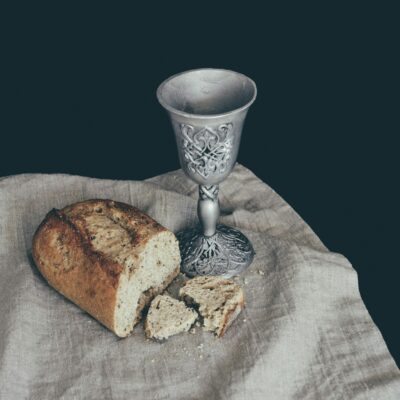This article is part of a series. To read the whole series, click here.
The Lord’s Supper, a central act of Christian worship, carries deep theological significance, connecting to Old Testament practices and shaping the church’s life today. Its roots in Passover, the call to guard the table, and its practical implications reveal its role as a means of grace that fosters reverence, repentance, and communion with Christ.
The Lord’s Supper finds its biblical precedent in the Passover, which Jesus celebrated with His disciples when instituting the sacrament (Luke 22:15). In the Passover, Israel commemorated deliverance from Egypt through the sacrifice of a lamb, whose blood protected them from judgment (Exodus 12:13). A scapegoat also symbolically carried away the people’s sins, pointing to forgiveness and freedom. The Lord’s Supper fulfills this imagery: Christ, the Passover Lamb, was sacrificed once for all, delivering believers from sin’s bondage (1 Corinthians 5:7). The Supper thus looks back to Christ’s death and resurrection, as Paul notes in 1 Corinthians 11:23–26, while fostering a solemn reverence akin to Passover’s call to repentance. It also looks forward, proclaiming Christ’s work “until He comes,” blending remembrance with eschatological hope.
Guarding, or “fencing,” the table ensures the Lord’s Supper is approached with due reverence. Paul warns in 1 Corinthians 11:27–29 that partaking “in an unworthy manner” brings judgment, as one fails to discern the body of Christ—His sacrificial body and the church as His body. Believers must examine themselves, confessing sin and affirming faith, to partake worthily. This practice protects both the individual and the church, preventing the judgment seen in Corinth, where some became weak, ill, or died (verse 30). Fencing the table is not about exclusion but invitation: the gate is open to those who know their need, repent, and submit to the church’s accountability, such as through baptism and membership.
The Lord’s Supper’s practical implications shape its celebration. It is a corporate act, reserved for the gathered church, fostering unity and mutual care (1 Corinthians 11:33). This communal focus rejects private participation, common in some traditions, emphasizing the church’s role as Christ’s body. The Supper demands reverence, as believers reflect on Christ’s once-for-all sacrifice, rejecting views like the Roman Catholic mass, which re-presents Christ’s sacrifice, contrary to Hebrews 7:27. Faith is the instrument of receiving Christ’s benefits, not mere participation, ensuring the Supper is a spiritual encounter, not a mechanical rite.
The question of paedocommunion—allowing young children to partake—arises in some circles. In Reformed theology, participation requires self-examination and discernment (1 Corinthians 11:28–29), which infants and young children cannot perform. Unlike baptism, an initiatory rite, the Lord’s Supper is an ongoing act of covenant renewal, necessitating understanding. Thus, children typically partake after profession of faith, ensuring they grasp the Supper’s significance.
In practice, the Lord’s Supper is a multifaceted act of worship. Believers remember Christ’s cross, sealing God’s promises of forgiveness and grace. They repent, examining themselves to approach the table worthily. The Supper deepens fellowship (koinonia) with Christ and His church, nourishing faith through the Spirit. It also stirs longing for Christ’s return, as each celebration anticipates the marriage supper of the Lamb (Revelation 19:9). Thomas Watson, a 17th-century AD Puritan, warned that neglecting the sacraments leads to spiritual weakness, urging believers to cherish this means of grace.
The Lord’s Supper, rooted in Passover and guarded by reverence, calls the church to worship with humility and hope. It unites believers in Christ’s finished work, strengthens their faith, and prepares them for His return, making it a vital expression of the gospel in the life of the church.
This is the fourth in a series on the Lord’s Supper, concluding our exploration of its meaning, scriptural basis, historical views, and practical significance.



